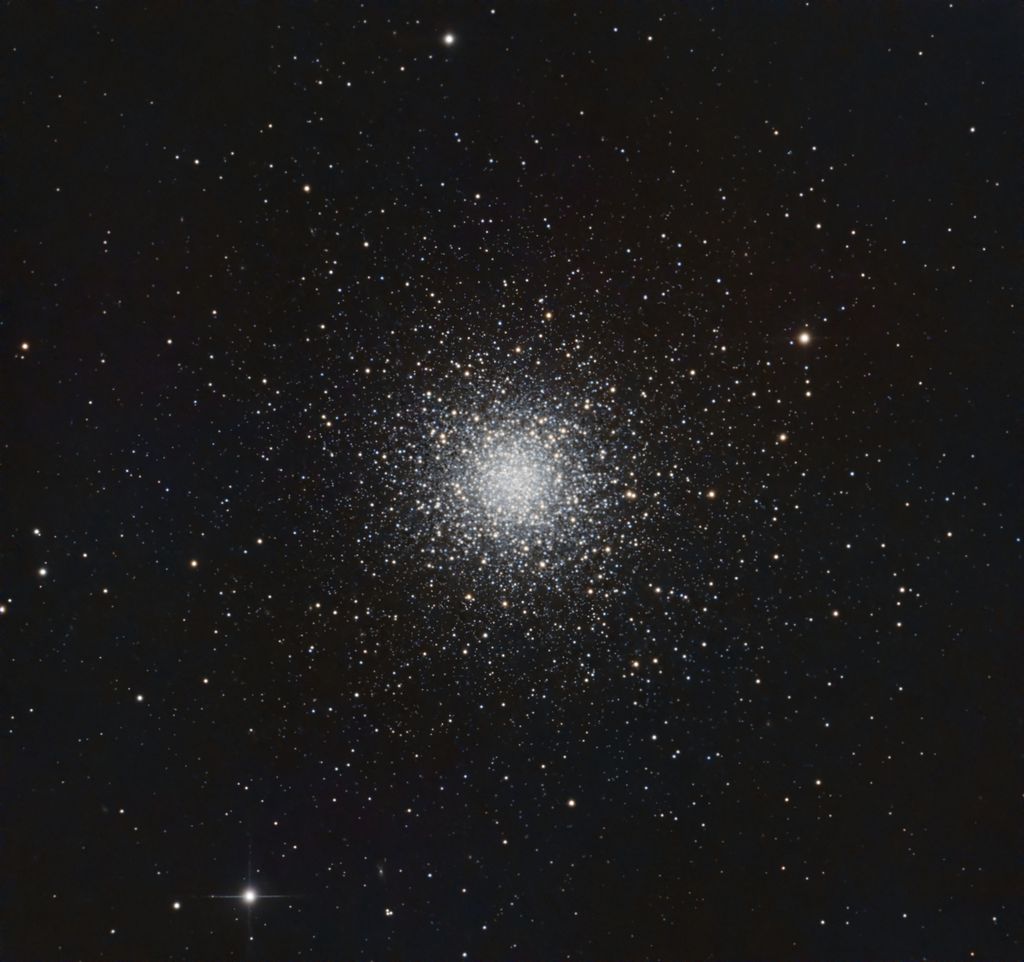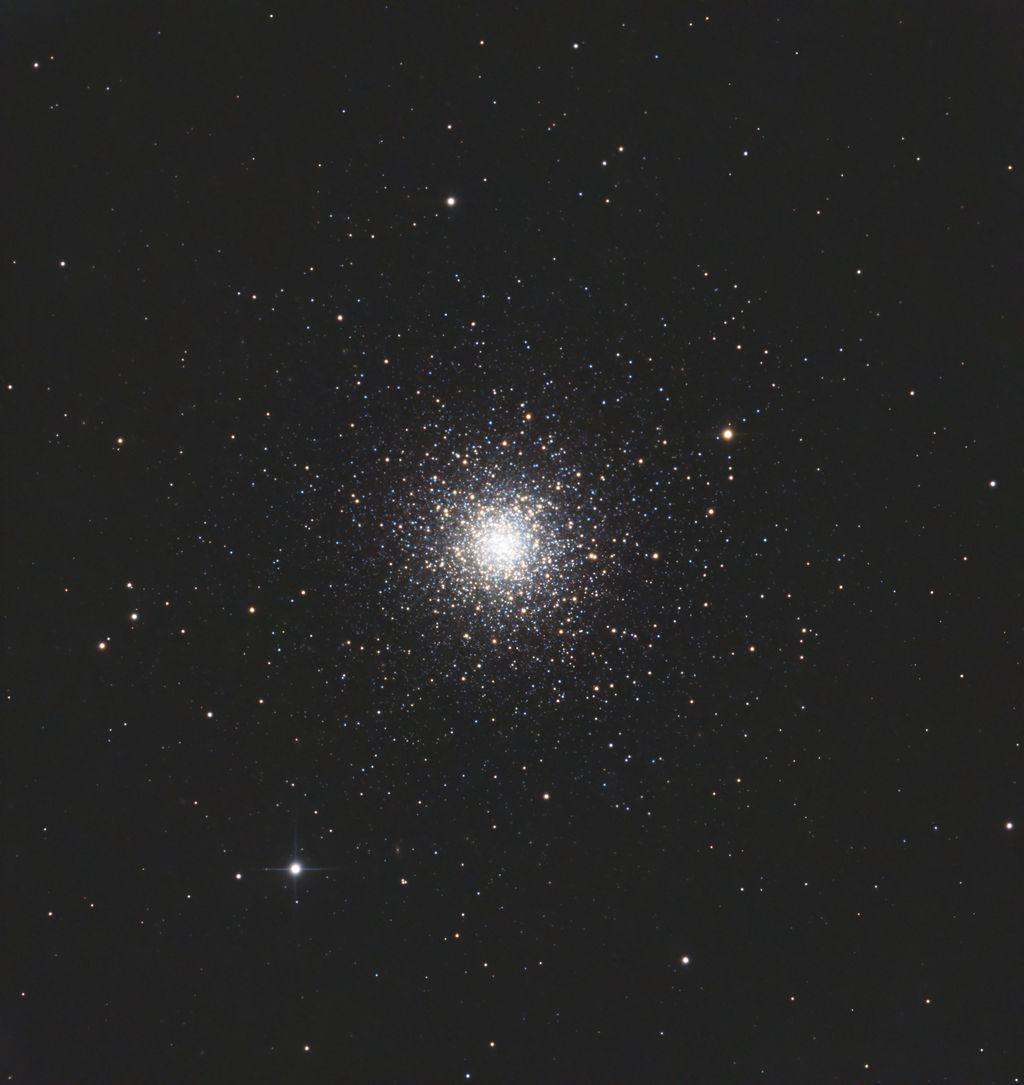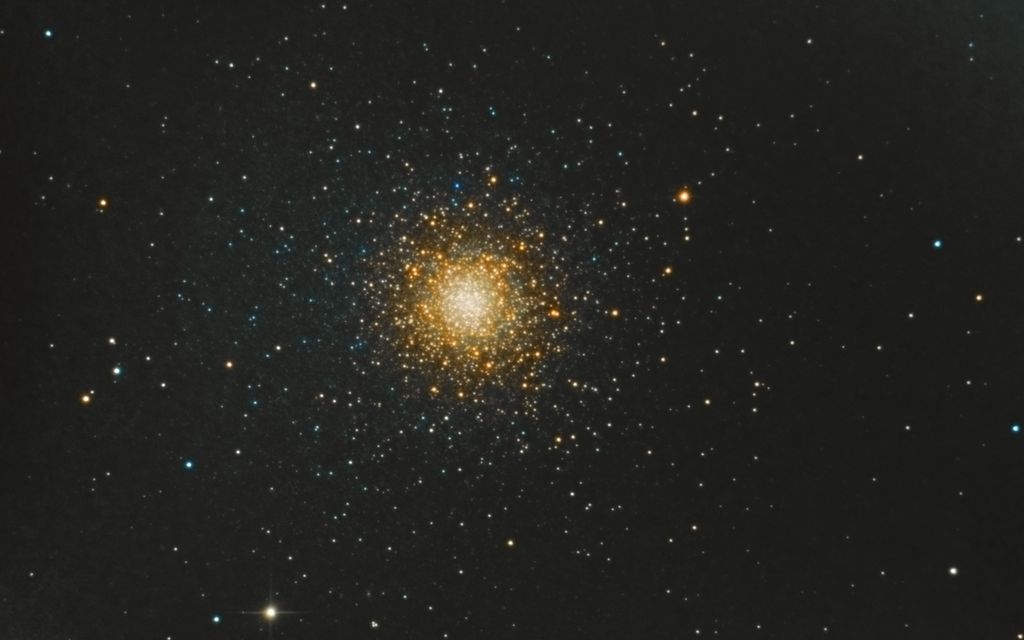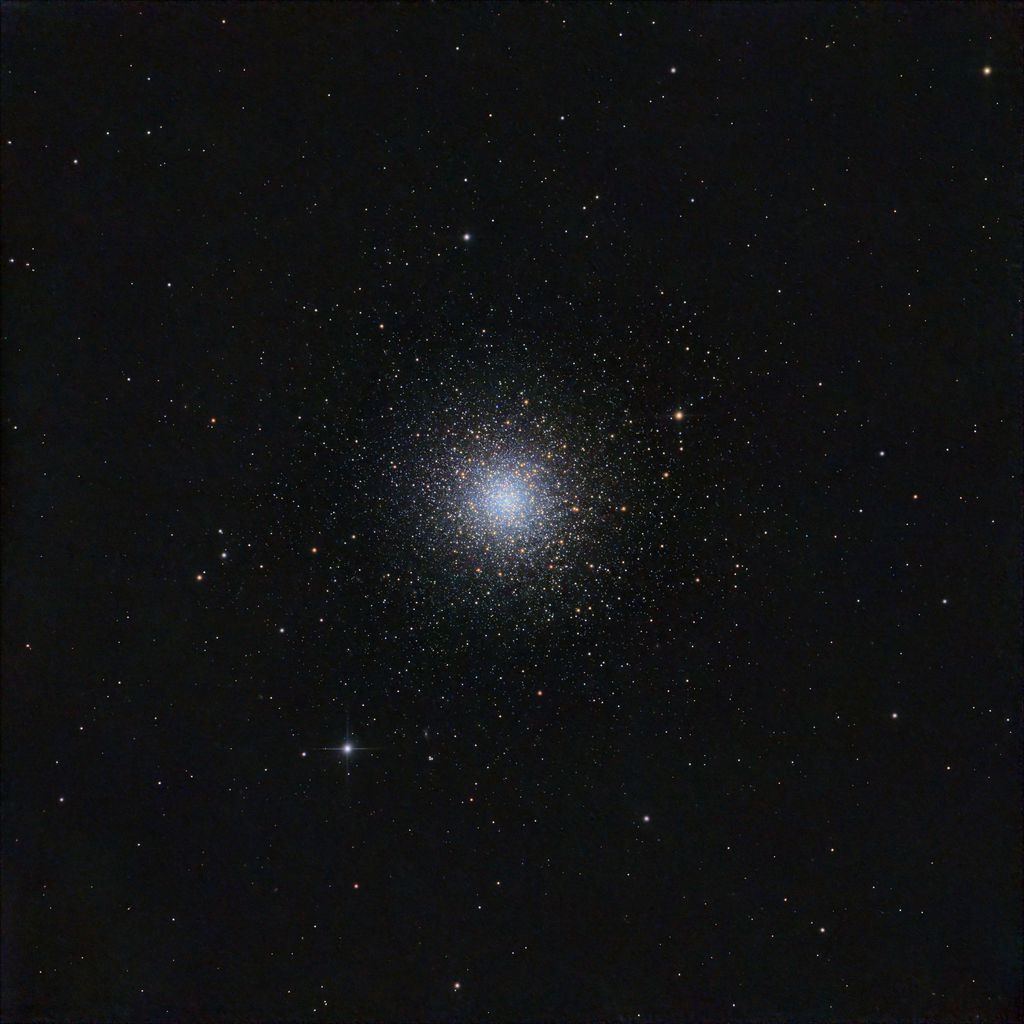Here is the OSC data https://filebin.net/ip21jp9nbja4v91b
It's full spectrum (no UV-IR cut), so UV/IR is overpowering the image (so star colors are lacking), and it was taken with no coma corrector, on a Newt, and there is no calibration frames, and it's a stack of 90x10 second subs (15 minutes integration).
Since now that I have a UV-IR cut (and a coma corrector), this M3 file is useless for me.
Will be gone from FileBin automatically in 6 days.
And M3 is not really a favorite target for me, so I don't mind anyone making a better image than my own.
I wanna see what others can do, especially Pixinsight and BXT users.
This is my version: https://www.astrobin.com/0qa87m/B/?nc=collection&nce=32422 Just Siril, Astrosharp, and some Photoshop.
|
You cannot like this item. Reason: "ANONYMOUS".
You cannot remove your like from this item.
Editing a post is only allowed within 24 hours after creating it.
You cannot Like this post because the topic is closed.
|
Hello mate! As I am on the learning curve too, I will download and play with it! Just processed M3 myself with data gathered yesterday. Globular clusters are relatively easy to process as you can darken the background with the appropriate masks without loosing any substantial data!. Integration time is what you need. I had initially 4.5 hours and went to 8 hours which revealed a lot more of those faint stars.
|
You cannot like this item. Reason: "ANONYMOUS".
You cannot remove your like from this item.
Editing a post is only allowed within 24 hours after creating it.
You cannot Like this post because the topic is closed.
Here is what I came up with:

I brought the tif file into APP then used that to neutralize the background, then used the light pollution removal tool to even things out which took me a few iterations, then I used the star color calibration tool, then I cropped it a little. After that I pulled it into PI so I could perform deconvolution and get those star shapes better. I then took it into Photoshop and finished things up with some selective sharpening, the camera raw filter, the hue and saturation adjustments, and photo filter adjustments using selections of shadows and highlights to mess with colors there, plus some curves and levels at times too.
|
You cannot like this item. Reason: "ANONYMOUS".
You cannot remove your like from this item.
Editing a post is only allowed within 24 hours after creating it.
You cannot Like this post because the topic is closed.
Scotty Bishop:
Here is what I came up with:

I brought the tif file into APP then used that to neutralize the background, then used the light pollution removal tool to even things out which took me a few iterations, then I used the star color calibration tool, then I cropped it a little. After that I pulled it into PI so I could perform deconvolution and get those star shapes better. I then took it into Photoshop and finished things up with some selective sharpening, the camera raw filter, the hue and saturation adjustments, and photo filter adjustments using selections of shadows and highlights to mess with colors there, plus some curves and levels at times too.
Very nice process! In such a short time!
|
You cannot like this item. Reason: "ANONYMOUS".
You cannot remove your like from this item.
Editing a post is only allowed within 24 hours after creating it.
You cannot Like this post because the topic is closed.
Omiros Angelidis:
Scotty Bishop:
Here is what I came up with:

I brought the tif file into APP then used that to neutralize the background, then used the light pollution removal tool to even things out which took me a few iterations, then I used the star color calibration tool, then I cropped it a little. After that I pulled it into PI so I could perform deconvolution and get those star shapes better. I then took it into Photoshop and finished things up with some selective sharpening, the camera raw filter, the hue and saturation adjustments, and photo filter adjustments using selections of shadows and highlights to mess with colors there, plus some curves and levels at times too.
Very nice process! In such a short time!
I'm the king of speed processing! Seriously, that took me only about 15 minutes tops. I think the most time I've actually spent processing something was still under an hour.
|
You cannot like this item. Reason: "ANONYMOUS".
You cannot remove your like from this item.
Editing a post is only allowed within 24 hours after creating it.
You cannot Like this post because the topic is closed.
This is my effort. Had to apply additional sharpening above BXT. Don't know if I like my effort. But this is a "Quicky". Standard PI OSC work-flow. I haven't played with the new gradient tool in PI yet so this was processed using DBE (twice - 1st Division , 2nd Subtraction).

I love processing images while drinking coffee and watching Soccer on a Saturday morning! 100% Edited with PixInsight with various PI utilities (R.C.'s- BXT,NXT).
CS Tim
|
You cannot like this item. Reason: "ANONYMOUS".
You cannot remove your like from this item.
Editing a post is only allowed within 24 hours after creating it.
You cannot Like this post because the topic is closed.
Scotty Bishop:
Here is what I came up with:

I brought the tif file into APP then used that to neutralize the background, then used the light pollution removal tool to even things out which took me a few iterations, then I used the star color calibration tool, then I cropped it a little. After that I pulled it into PI so I could perform deconvolution and get those star shapes better. I then took it into Photoshop and finished things up with some selective sharpening, the camera raw filter, the hue and saturation adjustments, and photo filter adjustments using selections of shadows and highlights to mess with colors there, plus some curves and levels at times too.
That's my favorite image. Look at all the background galaxies! There's like 30 all over the image! Hard to believe this came from my setup!
Just plz don't publish publicly; these edits will only be visible from this thread; I had no idea my data could be this good.
It's obvious I need Pixinsight.
|
You cannot like this item. Reason: "ANONYMOUS".
You cannot remove your like from this item.
Editing a post is only allowed within 24 hours after creating it.
You cannot Like this post because the topic is closed.
I tried Starnet, to try to remove the stars, so I can see the galaxies, but Starnet took away the galaxies too (besides 1 at the bottom of the image) 
What's strange though is that the Starless image looks like it has nebulosity:

Doesn't it look like there are very faint ripples, and some dark structures?
|
You cannot like this item. Reason: "ANONYMOUS".
You cannot remove your like from this item.
Editing a post is only allowed within 24 hours after creating it.
You cannot Like this post because the topic is closed.
I also have 2 questions:
1. Does Starnet always remove background galaxies? Does SXT also do that?
2. Scotty, how do are you able to do such deep annotating? Do I need a higher Astrobin membership?
EDIT: @Tim Ray, I also like your image, it's the second best so far.
|
You cannot like this item. Reason: "ANONYMOUS".
You cannot remove your like from this item.
Editing a post is only allowed within 24 hours after creating it.
You cannot Like this post because the topic is closed.
Here is my take:
https://www.astrobin.com/vdpygx/
Graxpert, SPCC, BlurX, MaskedStretch, (watered down) NoiseX, Curves for saturation and that "enhance brilliance" script which I am not so sure did much. Also, I resampled it at 75%.
|
You cannot like this item. Reason: "ANONYMOUS".
You cannot remove your like from this item.
Editing a post is only allowed within 24 hours after creating it.
You cannot Like this post because the topic is closed.
I also have 2 questions:
1. Does Starnet always remove background galaxies? Does SXT also do that?
2. Scotty, how do are you able to do such deep annotating? Do I need a higher Astrobin membership?
EDIT: @Tim Ray, I also like your image, it's the second best so far.
I ran for the first time StarXterminator (SXT) on a globular cluster. The results were odd. I won't bore anyone with the image. However, I use SXT on all sorts of images and for the most part leaves the background galaxies and other structures in the images. It does a much better job than StarNet and StarNet2. The RC apps (BXT, NXT and SXT) for PI were game changers for my image processing.
CS Tim
|
You cannot like this item. Reason: "ANONYMOUS".
You cannot remove your like from this item.
Editing a post is only allowed within 24 hours after creating it.
You cannot Like this post because the topic is closed.
Scotty Bishop:
Here is what I came up with:

I brought the tif file into APP then used that to neutralize the background, then used the light pollution removal tool to even things out which took me a few iterations, then I used the star color calibration tool, then I cropped it a little. After that I pulled it into PI so I could perform deconvolution and get those star shapes better. I then took it into Photoshop and finished things up with some selective sharpening, the camera raw filter, the hue and saturation adjustments, and photo filter adjustments using selections of shadows and highlights to mess with colors there, plus some curves and levels at times too.
That's my favorite image. Look at all the background galaxies! There's like 30 all over the image! Hard to believe this came from my setup!
Just plz don't publish publicly; these edits will only be visible from this thread; I had no idea my data could be this good.
It's obvious I need Pixinsight.
1. Does Starnet always remove background galaxies? Does SXT also do that?
2. Scotty, how do are you able to do such deep annotating? Do I need a higher Astrobin membership?
Getting it ready was mostly done with Astro Pixel Processor, with the background modelization (remove light pollution tool) and calibrating the star colors using that tool. I wrote a tutorial way on back and then imported it into the articles section of the Telescope Live forums. I seriously need to update it though after learning some more information and having newer versions hit, but this will get you through the evening out the background part: https://community.telescope.live/articles/software-tutorialsreviews/using-app-to-remove-gradients-and-light-pollution-r133/
The main thing I used PI for was only deconvolution so I could get all the stars round.
For the rest of it that was Photoshop all the way. Here is a link to some of the stuff I do with Photoshop. If you look at my gallery nearly all of it is only APP and Photoshop. https://community.telescope.live/articles/photoshop-tutorials/
I do not use Starnet or Star Exterminator (both are also able to be used for Photoshop) for globular clusters unless I am trying to pull IFN or nebulae from the background. It should nto remove background galaxies because it is mainly looking for point sources like stars. Here is an example where I used SX in Photoshop. It got me the AAPOD for January 20th of this year too. https://www.aapod2.com/blog/omega-centauri-ifn
As for the deeper annotations, that is because I have the highest subscription here. I get unlimited uploads and all the features too.
I had no plans on publishing your work publicly since it is your data and you only wanted to see what others could do as a processing challenge. As you can see I did not watermark it and I left it in my staging area. If you want you can download it and take a good look at it. All I would ask is if you post it just give me a mention. Still, it is your data and all I did was spend a short amount to time processing it for your challenge.
|
You cannot like this item. Reason: "ANONYMOUS".
You cannot remove your like from this item.
Editing a post is only allowed within 24 hours after creating it.
You cannot Like this post because the topic is closed.
Here is my take:
https://www.astrobin.com/vdpygx/
Graxpert, SPCC, BlurX, MaskedStretch, (watered down) NoiseX, Curves for saturation and that "enhance brilliance" script which I am not so sure did much. Also, I resampled it at 75%.
Your edit is my new 2nd favorite
|
You cannot like this item. Reason: "ANONYMOUS".
You cannot remove your like from this item.
Editing a post is only allowed within 24 hours after creating it.
You cannot Like this post because the topic is closed.
Scotty Bishop:
Scotty Bishop:
Here is what I came up with:

I brought the tif file into APP then used that to neutralize the background, then used the light pollution removal tool to even things out which took me a few iterations, then I used the star color calibration tool, then I cropped it a little. After that I pulled it into PI so I could perform deconvolution and get those star shapes better. I then took it into Photoshop and finished things up with some selective sharpening, the camera raw filter, the hue and saturation adjustments, and photo filter adjustments using selections of shadows and highlights to mess with colors there, plus some curves and levels at times too.
That's my favorite image. Look at all the background galaxies! There's like 30 all over the image! Hard to believe this came from my setup!
Just plz don't publish publicly; these edits will only be visible from this thread; I had no idea my data could be this good.
It's obvious I need Pixinsight.
1. Does Starnet always remove background galaxies? Does SXT also do that?
2. Scotty, how do are you able to do such deep annotating? Do I need a higher Astrobin membership?
Getting it ready was mostly done with Astro Pixel Processor, with the background modelization (remove light pollution tool) and calibrating the star colors using that tool. I wrote a tutorial way on back and then imported it into the articles section of the Telescope Live forums. I seriously need to update it though after learning some more information and having newer versions hit, but this will get you through the evening out the background part: https://community.telescope.live/articles/software-tutorialsreviews/using-app-to-remove-gradients-and-light-pollution-r133/
The main thing I used PI for was only deconvolution so I could get all the stars round.
For the rest of it that was Photoshop all the way. Here is a link to some of the stuff I do with Photoshop. If you look at my gallery nearly all of it is only APP and Photoshop. https://community.telescope.live/articles/photoshop-tutorials/
I do not use Starnet or Star Exterminator (both are also able to be used for Photoshop) for globular clusters unless I am trying to pull IFN or nebulae from the background. It should nto remove background galaxies because it is mainly looking for point sources like stars. Here is an example where I used SX in Photoshop. It got me the AAPOD for January 20th of this year too. https://www.aapod2.com/blog/omega-centauri-ifn
As for the deeper annotations, that is because I have the highest subscription here. I get unlimited uploads and all the features too.
I had no plans on publishing your work publicly since it is your data and you only wanted to see what others could do as a processing challenge. As you can see I did not watermark it and I left it in my staging area. If you want you can download it and take a good look at it. All I would ask is if you post it just give me a mention. Still, it is your data and all I did was spend a short amount to time processing it for your challenge.
All the edits from others will be contained only within this thread; I know you allow me to post it on my gallery, if I mention you, but it still feels like cheating, and I wont be able to live with the feeling. All my own edits, even if they look like garbage, will stay in my gallery; I know I'll get better in processing later, and then I'll upload revisions.
Thanks for all the information!
You're the winner of the challenge.
|
You cannot like this item. Reason: "ANONYMOUS".
You cannot remove your like from this item.
Editing a post is only allowed within 24 hours after creating it.
You cannot Like this post because the topic is closed.
Hi, this is my take on your M3. I used Graxpert, StarTools and Gimp. My goal was to resolve the stars in the core and preserve color.
CS Haakon |
You cannot like this item. Reason: "ANONYMOUS".
You cannot remove your like from this item.
Editing a post is only allowed within 24 hours after creating it.
You cannot Like this post because the topic is closed.
Haakon Rasmussen:
Hi, this is my take on your M3. I used Graxpert, StarTools and Gimp. My goal was to resolve the stars in the core and preserve color.
CS Haakon
Yours, I think, has the best color. Very nice edit!
|
You cannot like this item. Reason: "ANONYMOUS".
You cannot remove your like from this item.
Editing a post is only allowed within 24 hours after creating it.
You cannot Like this post because the topic is closed.
I've never really done much with star clusters, so I don't know what's good/bad or what a typical workflow is. I did crop, gradientcorrection, SPCC, BlurX, NoiseX, Histogram, SCNR (100% green), and curves for color saturation. I originally was trying with GHS, but just wasn't a big fan of what I was getting with it. |
You cannot like this item. Reason: "ANONYMOUS".
You cannot remove your like from this item.
Editing a post is only allowed within 24 hours after creating it.
You cannot Like this post because the topic is closed.

Here is my aggresive processing effort!
Everything in PI. My standard workflow. Still learning and still have long way to pefection.
|
You cannot like this item. Reason: "ANONYMOUS".
You cannot remove your like from this item.
Editing a post is only allowed within 24 hours after creating it.
You cannot Like this post because the topic is closed.
I gave it a whirl as well. There were some pretty nasty gradients and what seemed like an OAG obstruction at one side, so perhaps it could do with a bit more cropping. All in all it cleaned up somewhat well so I didn't see any need for crushing the black point any more than necessary.
Pretty simple, quick and straight forward processing:
1. Crop
2. BXT Correct only
3. GraXpert (due to the gradients)
4.GHS (Initial stretch)
5. HT stretch (four passes)
6. Nxt
7. BXT (very very small amount of star sharpening, 0.09). Opted against using this, but changed my mind after stretching.
8. SXT
9. NXT (small amount on the starless image)
10. ColorSaturation on stars image
11. Screening stars back with Pixelmath.

EDIT: Added another edit where I moved the black point slightly as there are still some color noise left from the aggressive gradient removal.
 |
You cannot like this item. Reason: "ANONYMOUS".
You cannot remove your like from this item.
Editing a post is only allowed within 24 hours after creating it.
You cannot Like this post because the topic is closed.
This is my try using Photoshop only
HLVG
Curves, Layer mask
Processed R, G, B channels separately.
 |
You cannot like this item. Reason: "ANONYMOUS".
You cannot remove your like from this item.
Editing a post is only allowed within 24 hours after creating it.
You cannot Like this post because the topic is closed.

Hi, this is my 10-minute-try using PI with ArcsinhStretch. I tried GHS, but didn't like it.
GraXPert
BackgroundNeutralization
ColorCalibration
BlurX
NoiseX
GHS linear for blackpoint
ArcsinhStretch for stretching
CurvesTransformation for contrast and color
SCNR on green
BlurX on stars only with very weak settings to improve small star sharpness and brightness
Johannes |
You cannot like this item. Reason: "ANONYMOUS".
You cannot remove your like from this item.
Editing a post is only allowed within 24 hours after creating it.
You cannot Like this post because the topic is closed.

1. Siril: background extraction (this one took the most trial and error with this image), photometric color calibration, initial stretches
2. Adobe Camera Raw: final stretches
|
You cannot like this item. Reason: "ANONYMOUS".
You cannot remove your like from this item.
Editing a post is only allowed within 24 hours after creating it.
You cannot Like this post because the topic is closed.
All nice edits!
I just bought PI, BXT, and NXT.
I'm gonna reedit my image, post it on my gallery, and I'll put a link here.
Let us see the processing prowess of Messierman The Noob!
|
You cannot like this item. Reason: "ANONYMOUS".
You cannot remove your like from this item.
Editing a post is only allowed within 24 hours after creating it.
You cannot Like this post because the topic is closed.
Ummm, it didn't go so well...
Lemme process it again. |
You cannot like this item. Reason: "ANONYMOUS".
You cannot remove your like from this item.
Editing a post is only allowed within 24 hours after creating it.
You cannot Like this post because the topic is closed.
Okay, I know now that HDR multiscale transform is not for globs.
So this is what I could do: https://www.astrobin.com/0qa87m/B/ |
You cannot like this item. Reason: "ANONYMOUS".
You cannot remove your like from this item.
Editing a post is only allowed within 24 hours after creating it.
You cannot Like this post because the topic is closed.
to create to post a reply.














